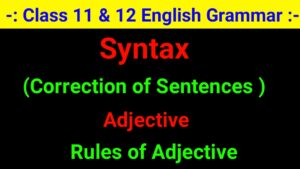Adjective
Adjective

Adjective (विशेषण) :- Adiective is a word that modifies noun or pronoun.
Adjective एक ऐसा शब्द होता है जो noun अथवा pronoun की विशेषता बतलाता है ।
Example –
(i) He killed his white dog.
(ii) Ravi is an intelligent boy.
Kinds of Adjective :-
Adjective निम्नलिखित दस प्रकार का होता है –
(1) Adjective of Quality
(2) Adjective of Quantity
(3) Adjective of Number
(4) Demonstrative Adjective
(5) Distributive Adjective
(6) Proper Adjective
(7) Interrogative Adjective
(8) Emphasizing Adjective
(9) Exclamatory Adjective
(10) Possessive Adjective
Our Mobile Application for Solved Exercise – https://play.google.com/store/apps/details?id=com.knowledgebeem.online
Adjective of Quality ( गुणवाचक विशेषण ) :- यह Adjective व्यक्ति या वस्तु के गुण को बताता है।
Example –
( 1) Ravi is a tall boy.
( 2) Ravi is an intelligent boy.
( 3) Delhi is a large city.
Adjective of Quantity (मात्रावाचक विशेषण) :- यह Adjective वस्तु की मात्रा का बोध कराता है।
Example –
(1) I lat some rice.
(2) I have enough money.
Adjective of Number (संख्यावाचक विशेषण) :- यह Adjective व्यक्ति या वस्तु की संख्या का बोध कराता है।
Note – यह Adjective व्यक्ति या वस्तु के क्रम का बोध भी कराता है।
Example –
(1) I have two pens.
(2) Some boys are in the class.
(3) I got first division.
Adjective of Numbr दो प्रकार का होता है –
(1) Definite – One, two, three, first etc.
(2) Indefinite – some, all etc.
Demonstrative Adjective ( संकेतवाचक विशेषण ) :- This, that, these, those, such etc. Demonstrative Adjective कहलाते हैं जब उनके प्रश्चात् किसी Noun का प्रयोग होता है ।इस Adjective का प्रयोग किसी Noun की ओर संकेत करने के लिए किया जाता है ।
Example –
(1) These boys are careless.
(2) l do not like such boys.
Visit Our Website for solved exercise – https://www.knowledgebeem.com
Distributiva Adjective (वितरण वाचक विशेषण) :- Each, Every, either, neither को Distributive Adjective कहा जाता है जब इनके पश्चात् Noun का प्रयोग होता है ।
Example –
(1) Neither book I liked.
(2) Each boy did his work.
(3) Every girl is in the class.
Proper Adjective (व्यक्तिवाचक विशेषण) :- Proper noun से बने Adjective को proper Adjective कहते हैं ।
Example –
American, Indian, European etc.
Interrogativa Adjective ( प्रश्नवाचक विशेषण ) :- यदि Interrogative word के पश्चात noun का प्रयोग हो तो वह Interrogative Adjective कहलाता है।
Example –
(i) Which book do you want ?
(ii) How many players are in the field ?
Emphasizing Adjective (बलवाचक विशेषण ) :- वह Adjective जिसका प्रयोग किसी noun पर जोर देने के लिए किया जाता है, Emphasizing Adjective कहलाता है ।
Example –
(1) I watched this movie with my own eyes.
(2) this is the same book which I lost.
Exclamatory Adjective ( आश्चर्यबोधक विशेषण ) :- जब what का प्रयोग किसी noun की विशेषता बदलाने के लिए प्रयोग किया जाता है तो इसे Exclamatory Adjective कहते है ।
Example –
What a player!
Possessive Adjective (अधिकार वाचक विशेषण ) :- जिन Adjective का प्रयोग अधिकार के लिए किया जाता है उन्हें Possessive Addective कहते हैं ।
Example –
(i) I bought my book.
(ii) You gave me your pen.
Formation of Complex Sentences by using Noun Clause – https://knowledgebeemplus.com/formation-of-complex-sentences-by-using-noun-clause/
Rules of Adjective
Rule – 1 Junior, senior, inferior (घटिया), superior ( श्रेष्ठ ) का प्रयोग comparative degree में होता है तथा इनके साथ than के स्थान पर to प्रयोग किया जाता है।
Example –
He is senior to me.
Rule – 2 Perfect ( पूर्ण), Extreme ( अत्यधिक ), Empty ( खाली ), Entire( सम्पूर्ण ), Complete, Unique (अव्दितिय) etc. यें शब्द सदैव ही अपने सर्वोच्च रूप में रहते हैं इसीलिए इनकी comparative व superlative degree नहीं बनायी जा सकती है।
Example –
This book is perfect.
Rula 3 – prefer ( अधिक पसन्द करना ), preferable इन दोनो में ही comparative degree का भाव होता है । अतः इनसे पहले more का प्रयोग नहीं होता है तथा than के साथ पर to शब्द का प्रयोग किया जाता है।
Example –
Milk is preferable to tea.
Rule – 4 Double comparative या double superlative degree का प्रयोग नहीं किया जाता है ।
Example –
Wrong – Ravi is the most best boy in the class.
Correct – Ravi is the best boy in the class.
To prepare notes please install our Mobile App – https://play.google.com/store/apps/details?id=com.knowledgebeemplus.online
Rule – 5 तुलना सदैव एक ही प्रकार के व्यक्तियो या वस्तुओं के बीच किया जाता है ।
Note – यदि तुलना भिन्न व्यक्तियो या भिन्न वस्तुओं के बीच दिखायी दे तो than के पश्चात् singular number के लिए that of का प्रयोग व plular number के लिए those of का प्रयोग किया जाता है ।
Example –
(i) The roads of Delhi are wider than those of Varanasi.
(ii) Ravi ‘s house is larger than that of his uncle.
Rule 6 Many व Much का प्रयोग क्रमश :पदार्थ की संख्या व मात्रा के लिए प्रयोग किया जाता है ।
Example –
I have many books.
Rule 7 little व few का comparative degree क्रमश : less व fewer होता है । less का प्रयोग पदार्थ की मात्रा के लिए व fewer का प्रयोग पदार्थ की संख्या के लिए किया जाता है ।
Example –
There are fewer bays in the class.
Rule 8 Comparative degree का प्रयोग दो व्यक्तियों या वस्तुओं की तुलना के लिए किया जाता है जबकि दो से अधिक के लिए Superlative degree का प्रयोग किया जाता है ।
Example –
(i) Ravi is the best of all the boys.
Rule 9 Some का प्रयोग affirmative Sentence मे तथा any का प्रयोग प्राय: negative व Interrogative sentence में प्रयोग किया जाता है।
Example –
Do you have any book?
Rule 10 little, a little व the the little का हिन्दी अर्थ क्रमश: ‘न के बराबर ‘ कुछ व ‘कुछ लेकिन सब’ होता है।
Our Telegram Channel – https://t.me/Knowledgebeem
For Complete Preparation of English for Board Exam please Visit our YouTube channel –
https://www.youtube.com/c/Knowledgebeem
Our Mobile Application for Solved Exercise – https://play.google.com/store/apps/details?id=com.knowledgebeem.online
Visit Our Website –
https://www.knowledgebeem.com


